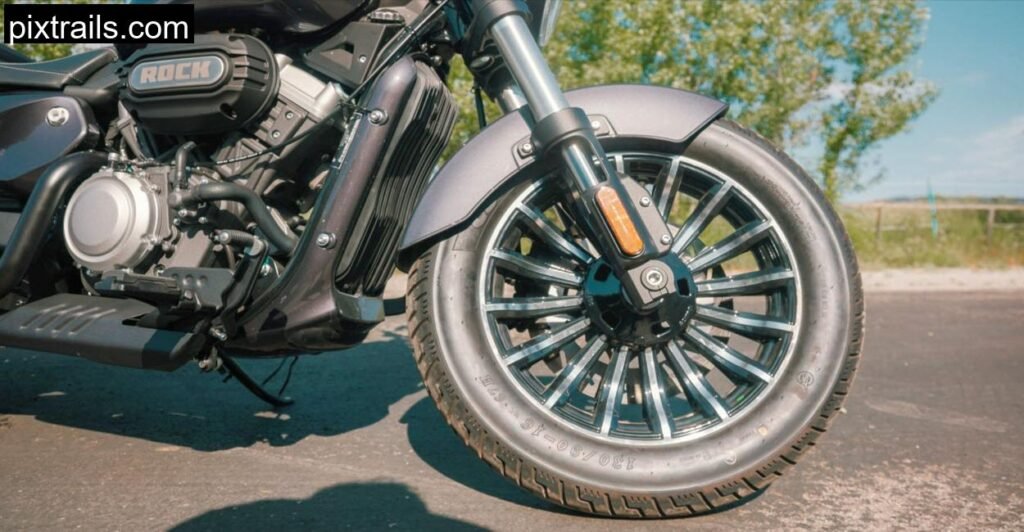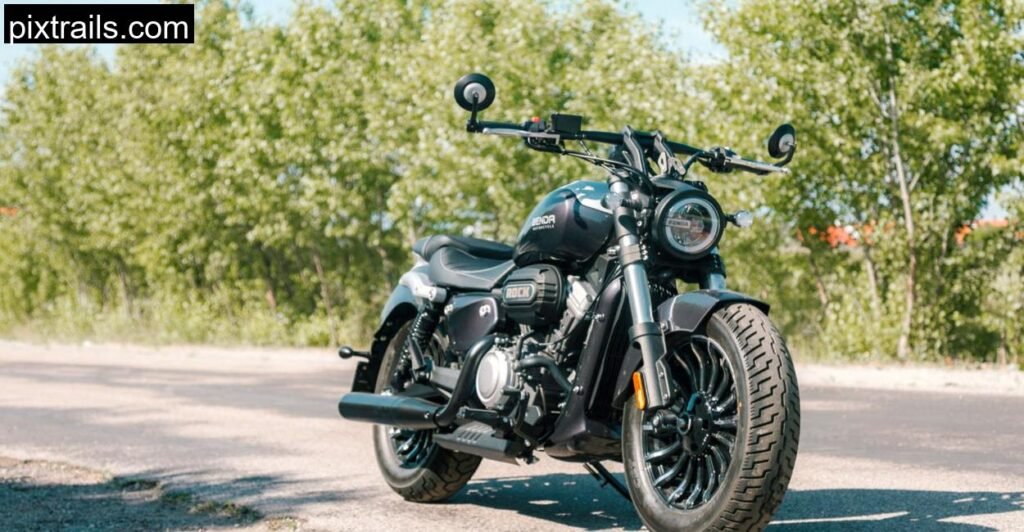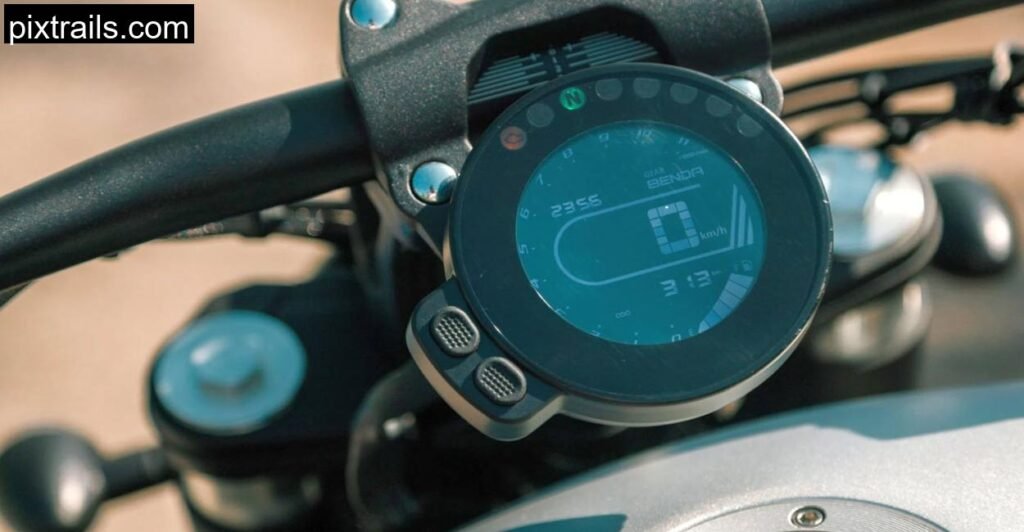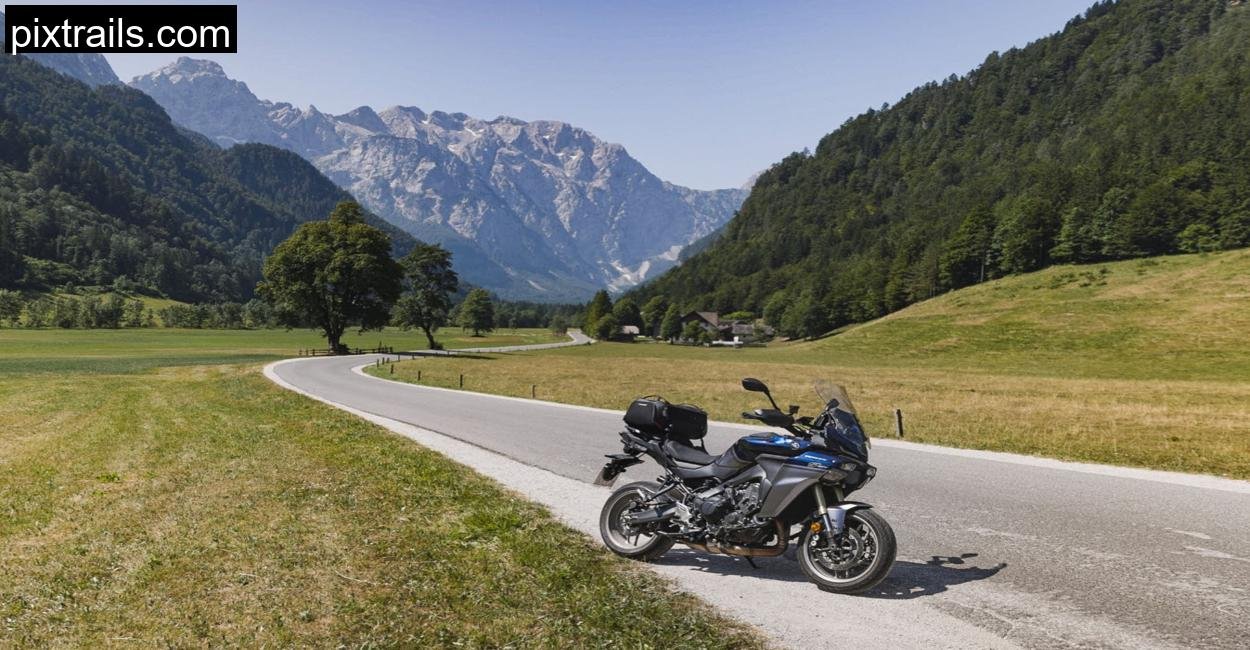The road that wraps around Levico Lake in northern Italy is a rider’s dream, smooth asphalt, gentle curves, and the kind of backdrop that makes you want to ride just a little slower so you can soak it all in. Mountains cradle the water in green arms, the light dances off the surface, and the air carries that crisp Alpine freshness with just a hint of pine. I had come here with one goal: to see if the Benda Rock 125 could live up to its promise of being more than just another 125cc.
On paper, it’s an unusual creature. This isn’t your average learner cruiser with a polite single-cylinder tucked inside. No, Benda went and gave it a V-twin engine. Yes, a proper V2, the kind you expect to see in bigger cruisers, not in the L-plate league. At first glance, it doesn’t even look like a 125. It’s long, low, and draped in metal parts that feel like they belong on a more expensive bike. And the price? €4,999. Ambitious for this class, but the spec sheet suggests they might just pull it off.
Technical Specification:
All technical details provided are taken from the Benda’s official manufacturer site. Specifications are based on the most recent data available at the time of review.
| Specification | Details |
| Engine Type | 125cc, 4-stroke, liquid-cooled V-twin |
| Power Output | 14 hp |
| Torque | ~10 Nm |
| Transmission | 6-speed manual |
| Final Drive | Belt drive |
| Front Suspension | Telescopic fork |
| Rear Suspension | Dual shocks |
| Brakes | Disc front & rear, CBS linked |
| Seat Height | 720 mm |
| Fuel Tank Capacity | 15 liters |
| Curb Weight | Approx. 165 kg |
| Price (Europe) | €4,999 |
First Impressions at Levico Lake
The moment I rolled the Rock 125 off its side stand and onto the lakeside promenade, it drew looks. Not the “aww, cute little learner bike” kind, but genuine curiosity, the kind usually reserved for something bigger. From the partially polished rims to the metal rear fender, there’s a sturdiness to it. The V-twin engine is proudly on display, and the paintwork catches the Italian sun in all the right ways.
Swinging a leg over, the 720 mm seat height immediately makes itself known. At 5’8” I could flat-foot it with ease, but even shorter riders will feel planted. The riding position is relaxed without being extreme, forward-set footrests, wide bars, and that low-slung cruiser stance that makes you feel in control before you even start the engine.
And then I did start it.
The ignition brings the V-twin to life with a low, warm rumble that is completely out of character for a 125. I’ve ridden plenty in this segment, most sound like sewing machines or hairdryers. This one? It actually purrs. Not loud, not obnoxious, but with just enough bass to make you grin.
Engine & Performance – More Character Than Muscle

Here’s the thing: it’s still a 14 hp bike. Physics hasn’t taken a holiday. If you’re expecting arm-yanking acceleration, you’ll be disappointed. But what it does have is a personality that most 125s can’t match.
Through Levico’s old town streets, I could lope along in fourth gear, engine burbling away happily, the belt drive keeping things smooth. When the road opened up toward the lake’s northern edge, I worked through the 6-speed gearbox, wringing it out past 9,000 rpm to keep pace with the faster traffic. That’s where you feel the limit, this is a bike that likes to cruise, not race.
Torque down low is modest, so quick overtakes require planning and a couple of downshifts. But here’s the kicker: because it’s a V-twin, even at high revs, the engine note never turns into the tinny whine you get from singles. It keeps its grown-up sound, and that alone makes the ride more satisfying.
Handling – Composed, Predictable, and Beginner-Friendly

The roads around Levico Lake are smooth ribbons that twist and turn gently, perfect for testing how a bike settles into corners. The Rock 125’s chassis feels planted, there’s no nervous twitchiness, even when you push it a bit.
Tipping into a bend is easy thanks to the wide handlebars, and the bike holds a line well. The 165 kg weight, while more than some 125s, actually works in its favor, giving it a mature, steady feel through sweepers. You won’t mistake it for a sports bike, but it doesn’t flop or wallow either, it’s just predictable.
The only thing that occasionally dampened the flow was the front brake. It works, but you have to give it a firm squeeze for proper stopping power. Fortunately, the CBS system is tuned well, press the rear brake and it brings in the front too, giving you decent all-round braking without drama. For new riders, that’s reassuring.
Comfort – Made for the Long Cruise
Cruisers live or die by their comfort, and here Benda has done their homework. The seat is wide enough for a couple of hours in the saddle without feeling like you’re sitting on a plank. The forward foot controls are placed so your knees aren’t locked straight, and the handlebar rise keeps your wrists neutral.
One unexpected highlight: the bar-end mirrors. They give a wide, clear view behind without forcing you to shift your head awkwardly. In the 125 world, that’s rare.
On my ride, I stopped halfway along the eastern shore of the lake, parked the Rock 125 in front of a small café, and sat outside with an espresso. The bike looked completely at home parked next to a row of bigger cruisers, no one gave it the “small bike” side-eye.
Design & Build Quality – More Metal, Less Plastic

Walk around the Rock 125 and you’ll notice details that you simply don’t see on most learner bikes. The metal rear fender is a standout, solid, painted beautifully, and giving the tail a premium look. The fuel tank’s metalwork feels solid too, and the polished wheel rims add just enough shine without looking overdone.
The circular LCD dash isn’t a design masterpiece, but it’s functional and easy to read, showing speed, revs, fuel, and gear position. Switchgear is standard-issue Chinese OEM stuff, functional but unremarkable.
Importantly, the welds are clean, nothing rattles, and there are no cheap-feeling plastic panels that flex if you press on them. At this price, it should feel well built, and it does.
Real-World Riding Around Levico Lake
The loop around the lake is about 10 km, with a mix of urban sections, lakeside cruising, and a few gentle hills. The Rock 125 handled it all without breaking a sweat. In town, the low seat and relaxed controls made it a breeze to filter through traffic. Along the lake, 70–80 km/h cruising felt comfortable, with the engine happily ticking over at mid revs.
On one stretch, I followed a local on a Piaggio Beverly scooter. He had the edge on acceleration out of tight corners, but once we were rolling, the Rock 125’s stability meant I could close the gap without pushing it hard. The ride quality over bumps was decent, those dual rear shocks aren’t luxury-soft, but they take the sting out of potholes.
By the time I pulled back into the hotel’s parking area, I realized something important: I’d been smiling the whole ride. Not because it was fast, but because it felt good.
Conclusion – A 125 That Feels Like a Full-Sizer
The Benda Rock 125 isn’t about speed or spec-sheet bragging rights. It’s about delivering the cruiser experience to riders who either can’t or don’t want to go bigger yet. The V-twin gives it character, the build quality gives it presence, and the ergonomics make it genuinely enjoyable to ride for more than just a quick trip to the shops.
Yes, €4,999 is steep for a 125, and if you just want cheap commuting, there are better-value options. But if you want a bike that feels more substantial, both in looks and in the way it rides, the Rock 125 is in a league of its own. Around Levico Lake, it was the perfect partner: relaxed, stylish, and with just enough soul to make you take the long way back.
Is the Benda Rock 125 good for beginners?
Yes. The low seat height, stable handling, and forgiving power delivery make it very beginner-friendly.
Can Benda Rock 125 handle highway speeds?
It will reach around 100–110 km/h, but it’s happiest at 70–90 km/h for comfort and engine smoothness.
How does the belt drive on the Benda Rock 125 influence the riding experience?
It makes the ride smoother and reduces maintenance compared to a chain, which is great for commuting and casual cruising.










